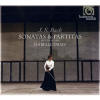Texte paru dans: / Appeared in:

Fanfare Magazine:34: 2 (11-12/2010)
Pour
s'abonner / Subscription information
Les abonnés à Fanfare Magazine ont accès aux archives du
magazine sur internet.
Subscribers to Fanfare Magazine have access to the archives of the magazine
on the net.
Harmonia Mundi
HMC902059

Code-barres / Barcode:
0794881943821 (ID036)
Consultez toutes les évaluations recensées pour ce cd
~~~~ Reach all the evaluations located for this CD
The easy way in which Isabelle Faust coaxes the tone from the 1704 Sleeping Beauty Stradivari might alone suggest a performance on period instruments, but the very quality of that tone seems more thoroughly modern, though pure and hardly cluttered with excessive vibrato. Such a timbre invests Faust’s probing reading of the second of Bach’s partitas with an effortless-sounding grace that belies the complexity of the reading. For example, though Faust doesn’t make the kind of slight breaks that Carl Flesch recommended in the Allemanda, she makes the movement personal—though objective—with ornamental additions and subtle dynamic shadings that continuously maintain interest. Her version of the Corrente proceeds at a rapid tempo that still allows ample room for detailed rhythmic explication of the leaping lines. She arpeggiates the Sarabanda’s chords and includes discreet ornamentation at the melody’s repetition. The movement ends in almost unprecedented repose and leads into a reading of the Giga that, though it begins quietly, turns into an onslaught of 16th notes (at this tempo, she doesn’t attempt much ornamentation, which, in any case, could easily be lost in the rapids). The venue seems to have been reverberant enough to allow the rapid notes almost to fuse into single harmonies. She begins the Chaconne quickly, with pauses between bow strokes rather than with sustained organ-like sonorities. At 12:28, it’s one of the fastest I’ve heard (the octogenarian Nathan Milstein brought it in at 12:41 in 1986 and Heifetz at 12:53 in his set from the mid 1950s and at 12: 45 in his recording from 1970), but it doesn’t gives the impression of steady, continuous forward motion rather than of speed. And the arpeggiated chords about five minutes into the movement sound as majestic at this tempo—and with this kind of approach—as they might at a more sedate tempo (and she provides a second barrage of arpeggios near the end that creates a sort of symmetry).
The Adagio of the Third Sonata, with its repeated patterns, sounds heavier—droning and even cumbersome—in Faust’s reading; the Fuga—the only fugue in this installment—despite its careful delineation of Bach’s entries and polyphonic lines and the rapidity of its tempo, doesn’t build to the overwhelming kind of climaxes that Nathan Milstein reached in his second set, although her restatement of the subject in bariolage double-stops dances with his energy. Her subtlety in the self-accompanied Largo and her exuberant bravura in the Allegro assai balance the weight of the opening two movements.
The Third Partita opens with a movement that’s often detached and played as a separate concert number. Faust sounds solid and assured—but also brilliantly quicksilver. She points the Loure’s rhythmic masonry even more effectively than did Yuko Shiokawa (Camerata 15081, Fanfare 32:5), and at a faster tempo and incorporating abundant ornamentation. Into the Gavotte en Rondeau, another of the movements from this partita to serve as an independent number, she also (but occasionally) inserts momentum-imparting ornament.
The reverberant acoustic and the close-up miking create an ambiance that enhances Faust’s musical authority (those who decry heavy breathing will encounter some here, albeit generally it’s pretty well absorbed into the violin playing). For Faust’s intellectual energy, for her tonal strength, and for the vibrant individuality of her playing, the compilation deserves a strong, if not an urgent, commendation as one of the most personal and most inventive after Milstein’s.
Cliquez l'un ou l'autre
bouton pour découvrir bien d'autres critiques de CD
Click either button for many other reviews


